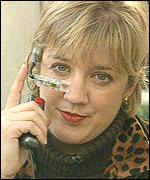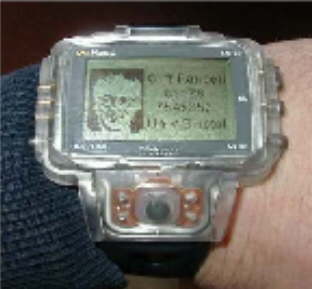|
|
|
EPSRC
Visualization and Virtual Environments Community Club (VVECC)
- Rutherford Appleton Laboratory |
|
Augmenting the
Real World: |
|
Augmented
Reality and Wearable Computing
|
A one day conference of the EPSRC Visualization and Virtual Environments Community Club dealing with augmenting the real world through the use of augmented reality and wearable computing was held at Loughborough University on 18 April 2000. The aim of the conference was the exploration of the intersection between real and computer maintained worlds. This was an extremely successful conference and brought together some of the leading practitioners from around the world. Two highlights of the event included a keynote address by Mark Billinghurst (Human Interface Technology Laboratory, University of Washington, USA) and a final summing up session by Professor Fred Brooks (Department of Computer Science, University of North Carolina, USA).
Roy Kalawsky - Conference Chair
Augmented Reality
Keynote Address - Research Directions in Wearable Computers - Mark Billinghurst Human Interface Technology Laboratory, University of Washington, Seattle
As computers become increasingly invisible the field of wearable computing has emerged as an important new computing paradigm. In this talk we briefly overview lessons learnt from the early years of wearable computers and then review several promising future research directions. These are based on three of the dominant characteristics of wearable computers; mobility, augmented reality and context sensitive computing. We describe fundamental research that has been conducted in each of these areas, review the lessons learnt and outline some design principles that can be applied to the next generation of wearable computers. Examples will be presented from research groups at the HIT Lab, British Telecom, The MIT Media Lab, and Sony Computer Science Labs among others.
Seeing into the Future: The potential of Augmented Reality for Advanced Embedded Training Systems - Alex Stedmon Kate Cook, Alison Young, Amanda O'Shea† & Lucy McLaughlin - DERA
The aim of this research was to identify any benefits from the use of real-time training feedback, and to investigate the utility of Augmented Reality (AR) technology for providing this feedback. Two main research questions have formed the basis of this research: · first, does the provision of online feedback lead to training benefits for task performance in a complex military decision-making task? Second, can this online feedback be provided via AR? AR can be described as a head mounted, see through display, providing visual augmentation to the real world. The real world could be terrain (as in the case of Head Mounted Displays in the cockpit), but for military training applications would more likely be existing computer displays and hardware. The advantage of using AR is that additional feedback information could be provided in the trainee's line of sight, overlaid upon the primary task display.
Experimental Research into Human Cognitive Processing in an Augmented Reality Environment - Kevin Hill & Roy Kalawsky, Advanced VR Research Centre, Loughborough University
AR technology is still in its infancy and consequently research into the cognitive human factors issues surrounding the use of AR systems is severely limited. To date there have been no formal guidelines to support the application of AR technology. The research being carried out at the Advanced Virtual Reality Research Centre at Loughborough University is an investigation of the cognitive ergonomics of AR technology and information processing issues that may arise through its use, particularly when information is presented via AR and overlaid upon one or more primary display surfaces such as a visual display unit. Initial research investigated comprehension and short term recall of information and the results demonstrated that AR is as effective as traditional display formats for presentation of information. Later research demonstrated that line of sight cueing information results in lower reports of subjective workload, and that re-accommodation between the AR display and the primary display need not affect reaction times. This research illustrates that an AR display used in a non-spatial registered mode can be of benefit to a number of application areas including supporting tasks undertaken on single or multiple display units. The potential of AR to provide additional information to users when they are dealing with a situation away from their primary display (e.g. team working or multiple display environments) is extremely effective in terms of reaction times and low stress levels, and can be seen as a major benefit in situations where modifications to existing hardware are impractical or too expensive.
Making Light Work in Augmented Environments - Eric Tatham Open University & Advanced VR Research Centre, Loughborough University
Some potential applications of augmented reality, such as architectural visualisation, will depend, in part, on convincing and 'seamless' visual integration of real and virtual worlds. Not only does achieving this depend on resolving the common issues of temporal and spatial registration but also on reconciling real and virtual lighting models in a satisfactory manner. The paper described the problems involved in accomplishing this, and discusses possible approaches to their resolution, including a new proposal for inferring plausible models of global illumination.
Wearable Computing
Augmented Art Galleries - Chris Baber, Birmingham University
There have been recent developments in museum education which seek to engage visitors in an active experience of exhibits. In museums, this can be achieved through working models and demonstrations, but how can one achieve similar goals in art galleries? In the gallery, paintings are static, 2D images, often with little accompanying information. Attempts to either add more information, with plaques on the walls, or to tamper with the paintings will clearly not be acceptable to the curators. We have been looking at methods for presenting information to visitors using different media. The goal is to produce context-sensitive information devices, e.g., by tracking visitors in a gallery space,and providing appropriate information for each painting. The notion of appropriateness is related to the visitor profile and to their current tour of the gallery. This talk will describe some of the techniques used. Our work is also concerned with the Cognitive Engineering issues associated with augmenting reality and with wearing computers, and the talk will consider user requirements and responses to the design ideas presented. The aim of the presentation is to present a Cognitive Engineering perspective on augmented reality and wearable computing, through the example of an augmented art gallery.
A User Interface Framework for Wearable Computing - Neill J. Newman and Adrian F. Clark, University of Essex
Anyone who has used a wearable computer in anger will realize that user interfaces based around the desktop mataphor do not work. Indeed, the majority of people researching wearables believe that they will eventually have a "multi-modal" interface, one capable of accepting speech as easily as typed input and mouse movements, and which can generate aural output as well as visual. The authors have developed Sulawesi, a multi-modal user interface framework. It is written in Java and has been proven on Linux and Windows. Sulawesi accommodates verbal and typed inputs and features a simple natural-language parser so that it can infer commands from reasonably colloquial English. Output can be rendered aurally or visually, with the decision of the medium to use being chosen by the user or, in some circumstances, by Sulawesi itself. This presentation described the principal features of Sulawesi, highlights some of the shortcomings of existing interaction devices, and outlines some applications of the framework.
An augmented reality tour guide for archaeological sites - David Johnston and Adrian Clark
Archaeological sites are an important part of Britain's heritage. However, tours around them often disappoint visitors because they are unable to visualize how the site must have appeared; and, of course, building physical reconstructions in situ is not permitted. The authors are developing an augmented reality tour guide application for such sites which uses a wearable computer with GPS positioning capability, driving a head-mounted display with orientation sensors. This system is able to position the wearer at the correct place in a 3D model of the site as it is likely to have appeared in the past, greatly improving the experience. This presentation described the hardware and software systems, including the model-generation phase.
In Field Computer for Human Factors based Evaluations - Roy Kalawsky, Advanced VR Research Centre, Loughborough University
Loughborough University have developed an in-field computer (iFC) as a development platform to support detailed human factors studies on next generation wearable computing systems. Research being undertaken in the AR area is being mapped ono the iFC to study human performance at a cognitive level. The prototyping system is very flexible and ideaaly suited to complex human factors studies. This presentation described the approach being taken in the development of the second generation iFC.
Wearable Computing: Bristol Fashion - Cliff Randell, Bristol University
The Bristol Wearable Computing Initiative was established in 1997 as a joint collaboration beween Hewlett-Packard and the University of Bristol with the aim of exploring potential applications of computing devices which are worn as unconciously as clothing or jewellery. Initial work with our CyberJacket, incorporating a CardPC, GPS, speech recognition and a wirelessly linked display, and our Locomedia software, which attached media objects to contexts such as location, revealed limitations both in current technology and our design. A revised design making use of event driven software, the internet, a hand-held browser and pingers, has resulted in a stable platform capable of being used to quickly prototype applications and then for testing them in the field. The talk describes some of the problems posed by wearable computing, and our solutions. Applications that we have prototyped are also outlined with discussions on their effectiveness.
![]() Associated movie
file (3.8Mb)
Associated movie
file (3.8Mb)
Final Summing Up Session - Professor Fred Brooks - University of North Carolina
Professor Fred Brooks very kindly agreed to summarise the whole conference with respect to the international scene. The audio of Professor Brooks extemporaneous remarks is available in MP3 format.
![]() MP3 audio of
Professor Fred Brooks NB nearly 7Mb
MP3 audio of
Professor Fred Brooks NB nearly 7Mb
![]()
Send questions and comments to r.s.kalawsky@lboro.ac.uk
Last updated 7 May 2000









